

Agonda Beach, in Canacona taluka, is fast turning into a favourite nesting place for Olive Ridley turtles, with 40 turtles having walked ashore and laying a whopping 4,140 eggs.
The number is probably higher since the forest guards are unable to count the eggs in one pit as a turtle laid these within the earmarked turtle nesting site.
This season, although the first turtle walked ashore 42 days later than the previous year, they have been coming regularly thereafter, and nearly averaging 100 eggs per nest, leaving the forest guards smiling gleefully.
“This is a spiritual experience for us. When a turtle walks ashore, we consider it walking into our home. It is not only our duty, but of everyone around to protect these turtles because they help balance our ecosystem,” says forest guard, Ankush Karakpur, whose mission is to release the hatchlings into the sea.
With Agonda Beach being declared a turtle nesting site, the number of tourists choosing the place as a holiday spot has increased because silence is now its selling point.
“Compared to other beaches of Goa, here, it is clean with a respectable number of deck beds, and all enjoying the scenery offered by the sea quietly,” says Susan as she walks her four-year-old son on the beach.
"There is a mutual respect between humans and nature,” she observes.
“Tourists who come here,” observes Ankush, “are a great helping hand because they don’t need to be told about the space that Olive Ridley turtles need for survival. There are times when they even share material about turtles with us.”
“Years ago,” recollects fisherman Pagi, “we ate the eggs of these turtles and consumed their meat little knowing that they were turning into an endangered species. It was the turtle guards who made us aware of this.”
If there is joy in Agonda, turtle guards in North Goa – the second turtle nesting site in Goa, the third being Galgibaga – are, as the saying goes, counting their eggs before the hatchlings walk into the sea.
Signboards in the turtle nesting site in Morjim indicate that 58 turtles have walked ashore to lay eggs, though there is no mention of the number of eggs laid as is the case with Agonda or Galgibaga in South Goa.
“They may not want to disclose the number of eggs laid because there were reports in the media, last year, that eggs were reported to have been stolen from this nesting site,” said Salvador, a local.
But, the number of turtles laying eggs – not only in Morjim, but also in nearby Vagator, Candolim and Ashvem – are keeping the turtle guards busy and happy.
“We have been instructed by the head office not to divulge any information,” explained a turtle guard confidentially.
The eggs of 58 turtles are incubating at the turtle site in Morjim and the first turtle walked ashore on Morjim beach on December 25, 2024, two days earlier than the previous year, and laid 112 eggs.
Last season, 68 turtles had laid 7,000 eggs at Agonda Beach, and the turtle guards and regular visitors to the beach are optimistic that the number will increase this season.
“The turtle guards keep a sharp eye on activities on the beach, and I think that is the first and best step forward. With them around, there is no noise and no light on the beach at night, and that is conducive to Olive Ridley turtles walking ashore,” says Ben from the UK, on his second visit to Goa.
For a change, and a good one at that, the Olive Ridley turtles walking ashore at Agonda are proof that Goa is at its best when the sound of the waves, breaking on its shores, can be heard.